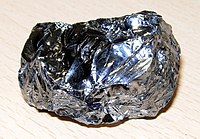
Photo from wikipedia
Facile synthesis of an imine compound through a greener route is still a challenging task. Industrial processes rely on the age-old Schiff reaction for the synthesis of imine, which are… Click to show full abstract
Facile synthesis of an imine compound through a greener route is still a challenging task. Industrial processes rely on the age-old Schiff reaction for the synthesis of imine, which are reversible and nongreen from an environmental viewpoint. Herein, cobalt-doped manganese tungstate with two different morphologies is synthesized and demonstrated as a recyclable catalyst for imine synthesis from the condensation of an aldehyde and an amine with 73% yield of an imine in a nonaqueous and nonacidic environment at room temperature. The high catalytic activity is attributed to cobalt doping, high surface area, strong acidic site, and the polar nature of the catalyst. The stability and recyclability test shows that the catalytic activity remains the same after several cycles, which is crucial from the industrial point of view. The formation of imine is found to follow an alternative mechanism in an irreversible manner with a polar four-membered intermediate unlike the conventional method. The demonstrated process has several advantages including irreversibility, "greener", environmental friendly, and energy-efficient.
Journal Title: Inorganic chemistry
Year Published: 2022
Link to full text (if available)
Share on Social Media: Sign Up to like & get
recommendations!